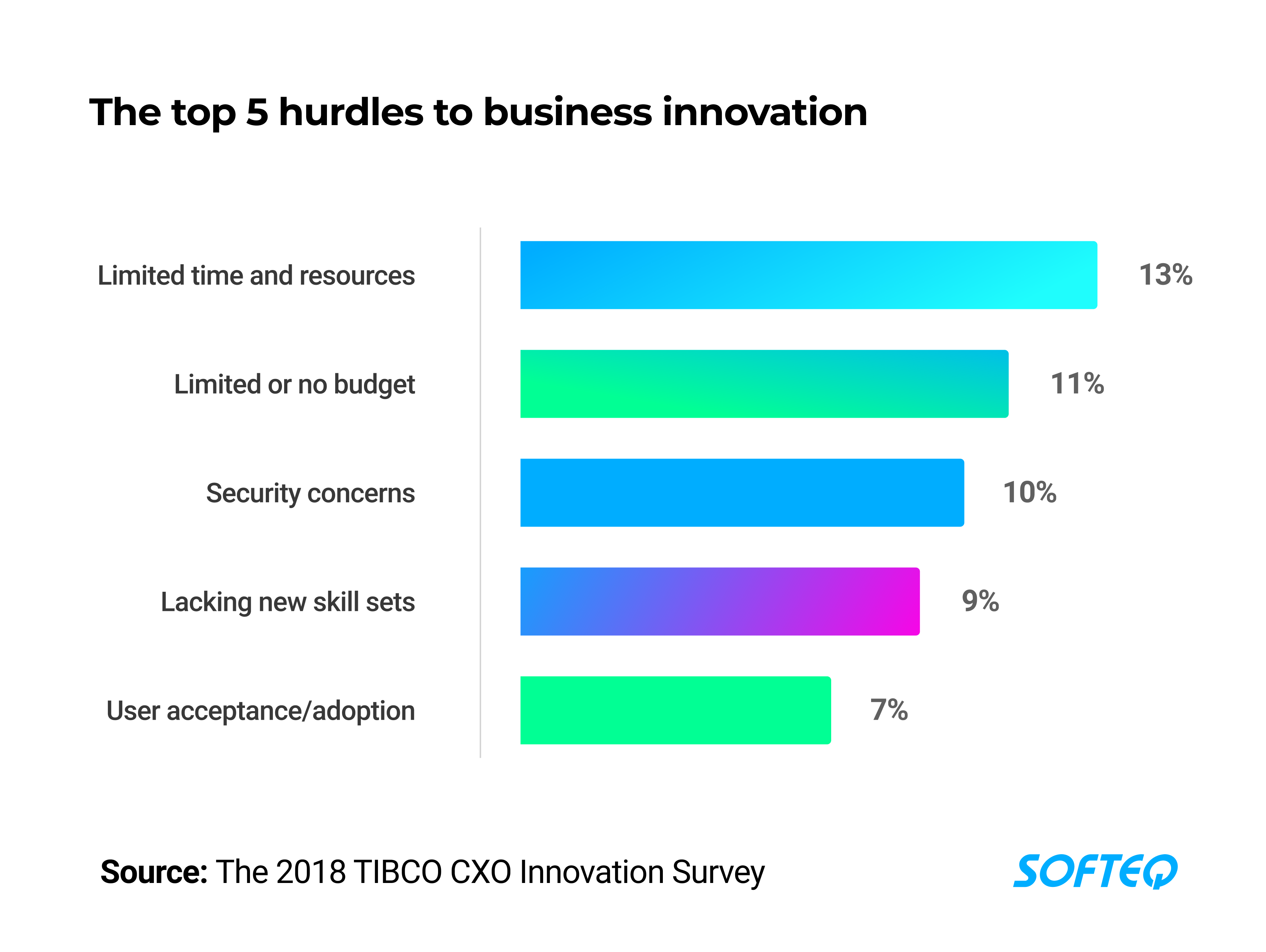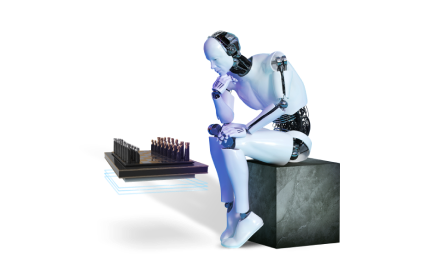The disruptive force of technology shortens companies' lifespans three times faster than it did decades ago. Will embracing transformation remain an option and not a must?
The industry is full of revolutionary technologies like AI & computer vision, mixed reality, and robotics. But large and middle sized companies often struggle to integrate innovations for fear of cannibalizing their own businesses.
In this article, we identify the main barriers to business innovation, focus on what helps intrapreneurs implement transformative technologies, see a real-world ROI, and uncover how a new initiative from Houston enables companies to thrive in the times of disruption 2.0.
The Top Hurdles to Business Innovation
Today, long-standing companies see the disruptive threat from newbies. A 2019 McKinsey study demonstrates that the average time for listing in Standard & Poor’s 500 has decreased from 35 years in the late 1970s to 20 years now. McKinsey believes that in 2027, an average S&P 500 placement will be about 12 years. In the meantime, enterprises that have started launching their startups are among the culprits of this turnover.
According to the survey, the crucial features that recently helped young companies innovate, grow, and scale rapidly over established enterprises include:
- Flexible use of their tech stack by creating stacks from scratch and mixing off-the-shelf components with legacy code
- Adaptable team members with qualities from particular industry backgrounds that have the ability to work in uncertainty and learn from mistakes as well as hire and motivate various specialists
- Fast-paced operations, multiple iterations, and constant pivoting within agile methodology
- Shared interests, which appeared in the form of equity stakes for employees
Limited time, resources, and budget are the leading obstacles to innovation in the enterprise, based on the answers of the 600 respondents of a 2018 TIBCO CXO Innovation Survey.

Here's How Intrapreneurs Can Start Implementing Transformative Technologies
1. Strategize with top technology trends in mind
The world of uncertainty and digital acceleration requires companies to keep up with trends in order to hold up well—introduce the product customers need, beat back industry competition, keep their business resilient, and generate real-world ROI. A single tendency may require revamping the whole strategy. Here’s a straightforward example: since the COVID-19 outbreak, facial recognition solutions gained more value than traditional fingerprint scanners.
From the spread of the Internet of Behavior solutions to hyperautomation and cybersecurity mesh—these are the top emerging tech trends to watch in 2021, according to Gartner. These trends cover three main topics—people centricity, resilient delivery, and location independence, which became a priority due to the pandemic.
The key trends, which will force businesses to accelerate digitalization in the upcoming year and beyond, according to the Forrester report, include:
- The growing need for ethical and responsible use of AI techniques
- Changes in automation roadmaps—the use of robotics solutions, pragmatic AI, and digital process automation
- Improved capability of large enterprises to operate hyperlocally
- The increasing role of cloud-native technologies in business innovation
2. Get access to innovations and innovators
It may seem that new companies are in a better position to innovate, but in reality, there are no limits to start. The truth is that the longer you shun the innovation track, the lower your rank will be among competitors and the slower your future growth.
McKinsey defines innovation as a combination of creativity and delivery, allowing companies to transform performance via a clear strategy, a pipeline of profitable ideas, a smart, fast, consistent execution, and a capable, mobilized organization.
In the field of engineering, the new wave of innovation involves the use of mixed reality, which combines AI-powered computer vision, wearables, 5G wireless cloud, and compelling 3D content. David Rose of Warby Parker calls this combination SuperSight.
Rose, as an innovation leader, is participating in the Softeq Innovation Lab that recently launched in Houston. This initiative has emerged to enable intrapreneurs and preeminent innovators to collaborate, thus helping enterprises implement transformative technologies at scale.
At the lab, executives and product leaders will work with innovators that have a track record of delivering 20X returns on innovation investment. Ann Brandy of Learn Launch Art Technology Group, Jinha Lee, founder and CEO of Spatial.io, and Matthew Kressy, founding director of Massachusetts Institute of Technology’s (MIT) Integrated Design and Management (IDM) program are among the masters who will lead sessions.

3. Get the right features with fast prototyping
A successful product relies on a killer feature the company chooses to show. With fast prototyping, it’s possible to focus on one, two, or three features for a demo without the necessity to build up the whole solution at one time. Christopher A. Howard, Softeq Founder and CEO, recommends starting with one essential feature your customer is happy about. It helps reveal what can be left out of an MVP, understand how much UI you need, and shorten extensive QA.
“I see lots of companies making big mistakes when they create version 3.0 of the software for their hardware products,” said Christopher A. Howard. “Their desire to fit everything in ends up delaying development. By the time they actually get to market, they come to discover that the customer was actually looking for something else entirely. Truly perfecting one thing is usually the secret to successful products.”
4. Environment for idea testing
Product success relies on robust technical expertise in the fields of hardware and software, access to useful frameworks and emerging technologies, including artificial intelligence, the possibility to create hands-on demos to demonstrate the main product features and present the solution in front of investors, as well as the right environment to build, test, and deliver.
Innovative ideas need a dedicated environment to test in before being implemented. The Boundless Bootcamp, which the Softeq Innovation Lab will host, brings this opportunity. The idea of the camp is to help product leaders and executive strategists in large and midsize organizations strategize, build, and scale tangible solutions in a short time frame. Intrapreneurs will have an opportunity to create a working prototype during a 5-day session, bring a prototype through its first round of testing and iteration within a 10-day sprint, and implement the product with its first users in 90 days.
Avoid These Mistakes
Disruptive innovation can come at a high price for companies that are wary of damaging their businesses and want to protect legacy revenue. This fear is a popular reason why stakeholders often turn down new ideas. At the same time, disruptive businesses entering the startup race face challenges around innovation and make the same mistakes over and over. Here’s the list of top faults, according to Christopher A. Howard, Softeq Founder and CEO:
- Not consulting with Account Managers before getting in front of customers to get feedback
- Not organizing a soft launch in front of a small group of friendly clients that understand that the product is not completely ready
- Not getting buy-in from upper management before the development stage, which can lead to a lack of support during the scale phase
To avoid these and any other mistakes while delivering the technologies of the future and driving breakthrough growth under the supervision of 20X innovators, join the Softeq Innovation Lab.
Section title
More articles on the topic







